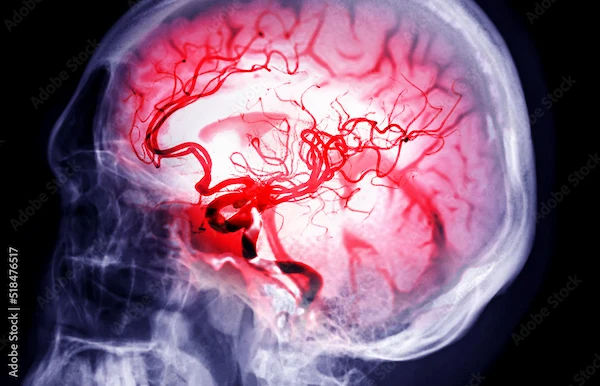Silent Stroke Facts
Strokes are one of the leading causes of disability and death worldwide. However, not all strokes present with dramatic symptoms such as loss of speech or paralysis. Some strokes, known as "silent strokes," can occur without noticeable symptoms but still cause serious damage to the brain. These strokes often go undetected and untreated, which can lead to long-term consequences. In this article, we’ll explore the key facts about silent strokes, how they affect your health, and what you can do to reduce your risk.

Written by Dr. Sonia Bhatt
Last updated on 3rd Jul, 2025

What is a Silent Stroke?
A silent stroke is a type of stroke that doesn’t cause noticeable symptoms, yet it still results in damage to the brain. Unlike traditional strokes, where individuals might experience sudden symptoms like weakness on one side of the body, slurred speech, or loss of vision, silent strokes often occur without any clear outward signs. Silent strokes are typically discovered through brain imaging, such as an MRI or CT scan, often done for other reasons.
While you may not experience symptoms, silent strokes can still cause damage to the brain’s vital tissue, particularly in areas responsible for cognitive functions, memory, and motor control. Over time, repeated silent strokes can lead to cumulative brain damage, increasing the risk of cognitive decline, dementia, or physical disability.
How Common are Silent Strokes?
Silent strokes are surprisingly common. Approximately 1 in 5 adults aged 60 or older may experience a silent stroke, and they are even more prevalent in individuals with risk factors like high blood pressure, diabetes, or a history of stroke. Despite their silent nature, these strokes are significant and should not be ignored. Silent strokes may occur without any noticeable signs, but their cumulative effect can be detrimental to overall brain health.
Causes and Risk Factors
Silent strokes occur when blood flow to a specific area of the brain is blocked, causing brain cells to be deprived of oxygen. This can happen due to a variety of underlying conditions that cause blood vessels to narrow or become obstructed, such as:
Atherosclerosis (hardening of the arteries): Fatty deposits or plaques in the blood vessels can restrict blood flow, increasing the risk of stroke.
High blood pressure (hypertension): Elevated blood pressure can damage blood vessels over time, leading to an increased risk of both silent and non-silent strokes.
Diabetes: Diabetes can contribute to the development of atherosclerosis and increase the risk of stroke.
Heart conditions: Conditions like atrial fibrillation, which causes irregular heartbeats, can increase the risk of blood clots, potentially leading to silent strokes.
Age and family history: The older you get, the more likely you are to experience a silent stroke. Additionally, a family history of strokes or cardiovascular conditions increases your risk.
In addition, lifestyle factors such as smoking, lack of physical activity, and an unhealthy diet can exacerbate the risk of silent strokes. Silent strokes can be caused by either large or small vessel disease, depending on which areas of the brain are affected.
How Silent Strokes Affect the Brain
Even though silent strokes don’t cause overt symptoms at the time of occurrence, they can still lead to significant damage to the brain’s tissue. The areas most commonly affected by silent strokes include those responsible for:
Memory and cognitive function: Silent strokes can cause damage to the hippocampus and other areas of the brain associated with memory and cognitive abilities. This may eventually lead to difficulties with concentration, memory loss, or even dementia.
Motor control: Silent strokes in brain regions involved in motor control may result in long-term issues with coordination or balance.
Mood and emotions: Damage to specific areas of the brain could also impact a person’s mood, leading to symptoms of depression or other emotional changes.
Importantly, these strokes do not typically cause immediate problems. However, over time, the cumulative damage from repeated silent strokes can contribute to progressive cognitive decline, even though the individual may not initially recognise these changes.
Symptoms of Silent Stroke
The term “silent” can be misleading, as these strokes can still cause damage, even if you don’t feel any specific symptoms. However, there are subtle warning signs that may indicate you’ve experienced a silent stroke, which can include:
Mild cognitive decline, such as memory problems or difficulty concentrating
Slight changes in mood or personality
Trouble with motor coordination, including balance issues or clumsiness
Difficulty finding the right words or processing complex information
Since the symptoms of silent strokes are often very mild or hard to notice, many people don’t realise they have had one until they experience more significant changes in their health. This is why regular monitoring and brain imaging can be essential, especially for those with high-risk factors.
Why Silent Strokes Are a Concern
The hidden nature of silent strokes is concerning for a few reasons:
Cumulative damage: While a single silent stroke may not result in noticeable symptoms, repeated strokes over time can have a compounding effect on brain function. This cumulative damage can significantly increase the risk of developing dementia or other cognitive disorders in later life.
Higher risk of a major stroke: Experiencing one silent stroke increases the likelihood of having another, and the subsequent strokes can lead to more severe outcomes, including full-blown strokes with noticeable symptoms.
Link to other diseases: Silent strokes have been associated with an increased risk of other health conditions, such as heart disease and linked to higher levels of disability.
Diagnosing Silent Strokes
Silent strokes are usually diagnosed incidentally during brain imaging for other reasons, such as when a patient undergoes an MRI or CT scan for memory problems, headaches, or other neurological concerns. In some cases, doctors may use brain imaging to assess the extent of damage in patients who have risk factors for stroke but no obvious symptoms.
If you are at higher risk for stroke due to factors like hypertension, diabetes, or a family history of stroke, it’s important to monitor your brain health with your healthcare provider regularly. Regular check-ups can help detect any early signs of silent strokes and allow for prompt intervention to prevent further damage.
Preventing Silent Strokes: Key Steps You Can Take
Preventing silent strokes involves addressing the underlying risk factors and adopting a healthy lifestyle. Here are some actionable steps you can take to reduce your risk:
Control blood pressure: High blood pressure is one of the primary risk factors for stroke. Aim to keep your blood pressure within a healthy range, typically below 140/90 mmHg. Talk to your doctor about lifestyle changes or medications that can help.
Manage your blood sugar: If you have diabetes or prediabetes, it’s crucial to manage your blood sugar levels through a healthy diet, regular exercise, and medication if necessary.
Quit smoking: Smoking damages blood vessels and increases the risk of both silent and non-silent strokes. Quitting smoking can have immediate benefits for your heart and brain health.
Exercise regularly: Regular physical activity, such as walking, cycling, or swimming, can help lower your blood pressure and improve overall cardiovascular health.
Eat a balanced diet: A diet rich in fruits, vegetables, whole grains, and lean proteins can reduce inflammation and improve circulation, lowering the risk of stroke.
Take medications as prescribed: If your doctor prescribes medications to manage risk factors like high blood pressure or cholesterol, follow their advice and take them consistently.
Get regular check-ups: Regular health screenings can help identify risk factors and detect early signs of stroke. This is especially important if you have a history of stroke or other cardiovascular diseases.
Conclusion
Silent strokes may not cause immediate symptoms, but they are still a significant health concern. They can lead to long-term cognitive decline, increase the risk of major strokes, and negatively affect quality of life. Understanding the risks and taking proactive steps to manage your health can reduce the likelihood of silent strokes and maintain better brain health throughout your life. Always consult your healthcare provider to discuss any concerns and take the necessary steps to protect your brain from the hidden dangers of stroke.
Consult Top Neurologist
Consult Top Neurologist

Dr. Uddalak Chakraborty
Neurologist
8 Years • MBBS, MD(GENL.MED.),DM(NEUROLOGY)
Kolkata
MCR SUPER SPECIALITY POLY CLINIC & PATHOLOGY, Kolkata

Dr. Abhinav Gupta
Neurologist
18 Years • MBBS, MD (GENERAL MEDICINE), DM (NEUROLOGY)
Ghaziabad
Bhava Neurocenter, Ghaziabad
Dr. Annakula Ramu
Neurologist
7 Years • MBBS, MD General Medicine, DM Neurology
Jagtial
Sairam Neuro and Children Hospital, Jagtial

Dr Rajashekar Mummadi
Neurologist
2 Years • MBBS, DNB General Medicine, DRNB Neurology
Hyderabad
Dr Ram's Neuro Clinic, Hyderabad

Dr Chandu Samba Siva Rao
Neurologist
7 Years • MBBS, MD GENERAL MEDICINE, DM NEUROLOGY
Vijayawada
Chandu Neuro Center, Vijayawada




